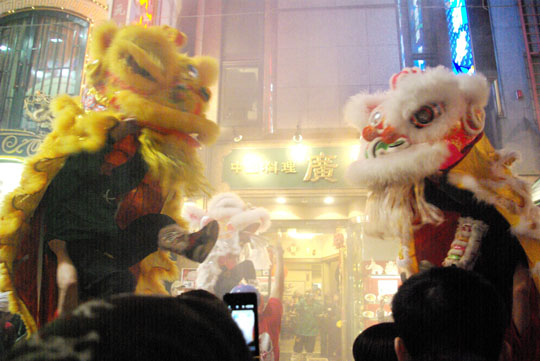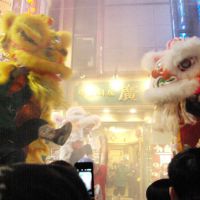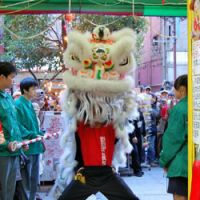With the beating of drums, the clang of cymbals and the popping of firecrackers, Yokohama's Chinatown welcomed in the new year, with festivities reaching a peak on Chinese New Year's, Jan. 26.
This year was the 22nd time for the Yokohama Chinatown Development Association to host the Chinese New Year Festival, according to Xie Cheng Fa, vice chairman of the association.
"We had been celebrating Chinese New Year's on our own before the association started the festival. My family also has been celebrating New Year's twice," said Xie, who grew up in Yokohama.
The association has been trying to bring the Yokohama event as near as it can in authenticity to its Chinese counterpart. In addition to showcasing their Chinese ancestry, it gives students in Chinese schools in Yokohama the opportunity to perform traditional dances.
"It's been about 10 years since we decided to focus more on the traditional performing arts," Xie said, adding that his son and grandson are also engaged in the performances. "We want to make the New Year's festival special."
One of the traditional dances performed in Yokohama Chinatown is the lion dance. The dancing beast is an imaginary lion meant to both exorcise evil spirits and summon in good luck and fortune.
The dance has both northern and southern styles. It is the latter, developed in Guangdong and Guangxi provinces, that is performed by the Yokohama Overseas Chinese School Alumni Association at the festival.
"The Chinese lion dance requires a lot of acrobatic movements," said Jinta Mori, 23, the dance team leader, who has been performing the dance for more than a decade.
"The alumni came to perform the lion dance when I was 9, and I found it really cool. That's why I got started," Mori said.
Mori explains that the Chinese lion dance is quite different from the Japanese shishi-mai, in which a small vermilion-color lion-like creature with a khaki cape dances with smooth, stealthy movements to the sound of the Japanese flute.
The Chinese lion dance is loud, cheerful and very colorful. The basic musical instruments used in the Chinese dance are a drum, cymbals and a gong.
Two dancers move the lion, one the head and the other the tail, with the person in front sometimes standing on the shoulders of the person in the tail. The Chinese lion is an expressive one, with the eyes, ears and mouth able to be moved. Vibrant yellows and golds, both considered lucky colors in China, add to the festive atmosphere.
Though many Japanese children are scared of the rather stern-looking Japanese lion, Mori says "kids like our lions because they're rather cute and fluffy,"
Four-year-old Shiho Monma loves the Chinese lion dance. She came to see the dance with her mother, Sayako, who says, "to her, the lion dance means Chinese lion dance. When she hears the sound of firecrackers, she wants to go out and see it," Sayako said of Shiho.
Barbara Kolff is another mother who brought her 6-year-old daughter and 4-year-old son, both excited by the sound of firecrackers. "We lived in Hong Kong for four years, so we had to come and have a look," said Kolff, who is originally from Holland.
Kolff moved from Hong Kong to Yokohama last August with her family when her husband was transferred to Japan. Being more familiar with Chinese culture than Japanese, Kolff was glad to see the familiar sights in Yokohama.
It is a joy for Xie to see visitors enjoying the dance and other performances for which people have practiced long hours.
"I hope we can pass on the traditional Chinese performances to the younger generation," he said.
Yokohama Chinatown celebrates the Chinese new year until Feb. 28. For further information see the Web site www.chinatown.or.jp




















With your current subscription plan you can comment on stories. However, before writing your first comment, please create a display name in the Profile section of your subscriber account page.